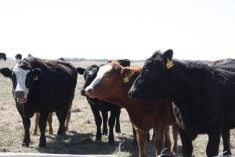This cattle market information is selected from the weekly report from Canfax, a division of the Canadian Cattle Association. More market information, analysis and statistics are available by becoming a Canfax subscriber by calling 403-275-5110 or at www.canfax.ca.
Lower fed prices
Fed cattle prices have been hovering in the low $240s per hundredweight for the past seven weeks, and it is a tale of two stories in Canada and the United States.
Read Also

VIDEO: Ag in Motion documentary launches second season
The second season of the the Western Producer’s documentary series about Ag in Motion launched Oct. 8.
Canadian fed cattle prices are at the lowest point since April, while U.S. fed prices are within $2 of record highs set in June. In Western Canada, feedlot margins have recently turned negative, and break-evens are projected to increase.
All three western Canadian packers procured cattle last week, and dressed sales were reported from $403-$408 per cwt. delivered. U.S. packer interest was noted, and light volumes of western Canadian fed cattle were marketed south.
Western Canadian steer carcass weights historically peak in late October. With longer pick-up times and good feeding conditions this fall, carcass weights might not peak until November.
Light trade was reported in Ontario with dressed sales at $406 per cwt. delivered, fully steady with the previous week. Light volumes of Ontario cattle were marketed to the U.S. and sales were at a premium over local deals.
In the U.S., dressed sales in Iowa and Nebraska were from US$298-$302 per cwt., $2 per cwt. higher than the previous week. Live sales in the northern feeding states were from $190-$192 per cwt., $2-$3 per cwt. higher, while southern regions traded from $189-$191 per cwt., $2 per cwt. higher.
For the week ending Oct. 12, U.S. beef cow slaughter totalled slightly more than 53,000 head, 25 per cent below last year. For the first half of October, this is the smallest slaughter since 2016. Year-to-date beef cow slaughter is down 17 per cent compared to last year, while year-to-date dairy cow slaughter is down 14 per cent.
Cull cows pressured
The non-fed market was mixed last week as seasonally larger volumes pressured cull cow prices.
Western Canadian D2 cows traded barely steady to $5 per cwt. softer, averaging $173.09 in Alberta. Manitoba D2 cows sold at a premium to both Saskatchewan and Alberta D2 cows.
Western Canadian D3 cows traded $2-$3 per cwt. softer to average $162.04 in Alberta, while Ontario D3 cows were around 50 cents stronger. Feeder cows in Alberta were $3 per cwt. softer, with rail grade cows $20-$35 per cwt. lower than the previous week.
Year to date non-fed slaughter, at 331,300 head, is 18 per cent smaller than last year and 12 per cent smaller than the five-year average. Western Canadian non-fed slaughter is down 16 per cent from last year and down 10 per cent from the five-year average.
Year-to-date eastern Canadian non-fed slaughter is 26 per cent smaller than last year and 19 per cent smaller than the five-year average.
Fall run underway
The fall calf run has kicked into full gear. Alberta auction volumes, at 81,277 head, were the largest this year but remain 10 per cent below last year and the five-year average.
Last week, light steer calves from 300-500 pounds rallied $19-$27 per cwt. from the previous week, with lightweight 300-400 lb. calves establishing a new annual high at $536 per cwt., up $26.98 per cwt. from last year’s peak.
Steer calves 400-500 lb. averaged $488 per cwt., $38 per cwt. stronger than last year’s annual high. Steers from 500-900 lb. and heavier rallied $3-$8 per cwt. compared to the previous week. Similarly, heifer calves 300-600 lb. rallied $22-$25 per cwt. from the previous week.
Heifer calves 300-400 lb. have traded stronger for six consecutive weeks, averaging $472 per cwt., $46 per cwt. above last year’s annual high. Heifers from 400-500 and 500-600 lb. have also traded stronger for five consecutive week, up $37 per cwt. and $3.50 per cwt. from last year’s peak, respectively.
Heifers from 700-900 lb. and heavier traded steady to $1 per cwt. stronger.
All classes of feeder cattle are now trading above last year. The last time similar auction volume trends were seen was 2013, which led to four consecutive weeks with more than 70,000 head.
For the week ending Oct. 12, feeder cattle exports to the U.S. were 4,399 head, down nine per cent from last year. However, this is the largest volume in 21 weeks and the largest western Canadian feeder export volume in 17 weeks.
Cutouts rise slightly
In U.S. beef trade, Choice cutouts came near the annual high set in July, but then fizzled out. Both Choice and Select cutouts ended the week 0.5 per cent stronger than the previous week, with Choice closing at $321.17 per cwt. and Select at $294.34 per cwt.
















